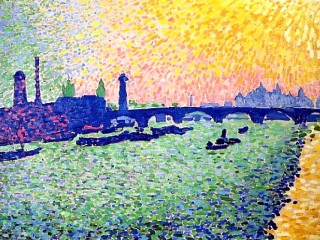
André Derain biography
Date of birth : 1880-06-10
Date of death : 1954-09-08
Birthplace : Chatou, France
Nationality : French
Category : Arts and Entertainment
Last modified : 2010-11-28
Credited as : Artist painter, avant-garde painter,
Andre Derain was considered by leading critics in the 1920s to be the most outstanding French avant-garde painter and at the same time the upholder of the classical spirit of French tradition.
Andre Derain was born on June 10, 1880, in Chatou. He began to paint when he was about 15. He studied at the Academy Carriere in Paris (1898-1899), where he met Henri Matisse. Derain was a close friend of Maurice Vlaminck, with whom he shared a studio in 1900 and also his radical views on painting, literature, and politics. Derain was drawn, through Vlaminck and Matisse, into the art movement known as Fauvism.
Derain's first artistic attempts were interrupted by military service (1901-1904), after which he devoted himself exclusively to art. He experienced impressionism, divisionism, the style of Paul Gauguin and Vincent Van Gogh, and Vlaminck's and Matisse's techniques by applying them to his own work. He copied in the Louvre and traveled a great deal in France to paint its various landscapes. He spent the summer of 1905 at Collioure with Matisse and that fall exhibited with the Fauves.
The art dealer Ambrose Vollard signed a contract with Derain in 1905, and the following year the artist went to London to paint some scenes of the city commissioned by Vollard. Derain's Westminster Bridge is one of his Fauve masterpieces.
About 1908 Derain became interested in African sculpture and at the same time explored the work of Paul Cezanne and early cubism. He became a friend of Pablo Picasso and worked with him in Catalonia in 1910.
In Derain's work, which comprises landscapes, figure compositions (sometimes religious), portraits, still lifes, sculptures, decors for ballets, and book illustrations, we can discern various periods, all of which are distinguished by masterpieces. About 1911 he was attracted by Italian and French primitive masters; he also admired the "primitive" art of Henri Rousseau. After World War I, during which Derain served at the front, he studied the masters of the early Renaissance and then Pompeian art. All these left traces in his work. Finally he emerged as a realist and intensified his contact with nature. In rejecting the cerebral art of cubism and abstraction, he defended the return of the human figure to painting. His development as an artist was dramatic, and although Picasso called him a guide de musees, in other words, not an innovator but a traditionalist, Derain's best work will survive many of the experimental attempts of his contemporaries because of its inherent painterly qualities.
Toward the end of his life Derain lived, practically forgotten, in his country home at Chambourcy. The retrospective exhibition in Paris in 1937 was the climax of his fame. He died in Garches on Sept. 2, 1954. The large retrospective exhibitions organized from 1955 to 1959 established a new appreciation of Derain as a major artist.
Denys Sutton, Andre Derain (1959), gives an objective picture of Derain's development and the attitude of critics to his work. Other monographs are Malcolm Vaughan, Derain (1941), and Gaston Diehl, Derain (trans. 1964).
Lee, Jane, Derain, Oxford: Phaidon; New York: Universe, 1990.
















